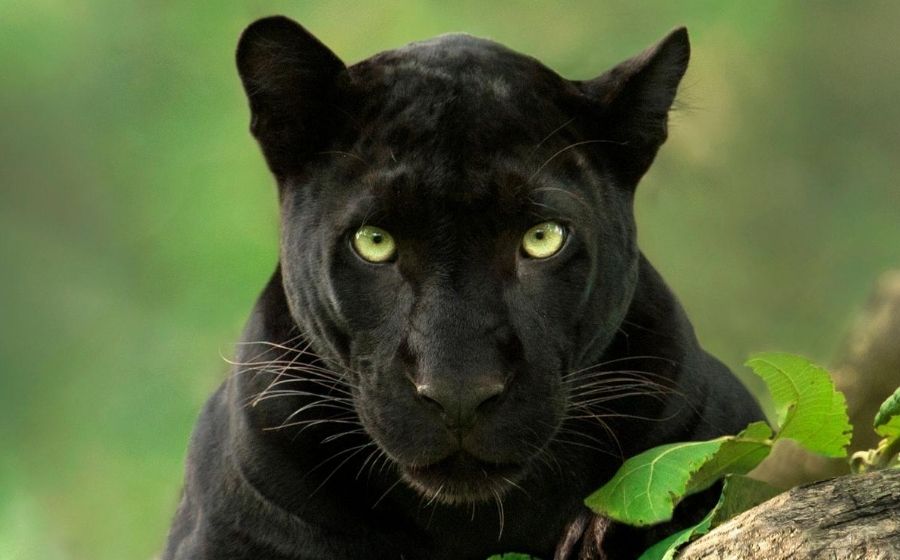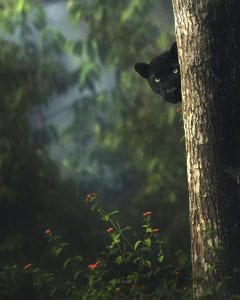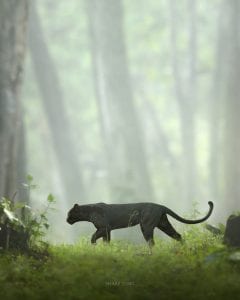
Three-year tracking of elusive black panther evolves into NatGeo documentary
When Saya the black panther moves along the undergrowth, shy forbidden and fascinating, he is like an approaching eclipse, that will cast spells on the earth that will take years to remove.

When Saya the black panther moves along the undergrowth, shy forbidden and fascinating, he is like an approaching eclipse, that will cast spells on the earth that will take years to remove.
Saya is not anything cosmic, but the black panther (known as jaguar in the US) is the hero of the mind-blowing documentary The Real Black Panther running now in Nat Geo channel available on the Disney Hotstar app. In the brilliance of the photography, the heart-tugging story told from Saya’s perspective, the 40 minute-documentary could easily rate as the best wildlife docu ever shot in India.
Such films which have the stamp of class and ambition, do not come easily. It is the work of Bangalore based naturalised and photographer Shaaz Jung, who spent three years and an average of ten hours everyday tracking and photographing this black King in the Nagarhole tiger sanctuary, about 250 km from Bengaluru.
It is difficult to point out any particular frame in this galaxy of stunning shots. But one of Saya lapping water from a pond, alone and wary, his green eyes scanning the horizons as it were, and tongue moving in slow motion, will blow your mind. The depth, the beauty and darkness of wildlife all come together in this divine moment. Adding to the power of the documentary is the story of Saya told in the first person, at once humanising an animal which is the stuff of legend.

The black panther is actually a leopard turned black due to skin pigmentation and called a melanistic leopard by scientists. Beneath the black pigment or coating can be seen the leopard’s spots. There is no racism among leopards and they treat their black brother as one of them and at the end of the movie, Saya finds a mate and both of them move together as a couple, proud owners of their territory in Nagarhole.
This Karnataka sanctuary on the banks of the Kabini river has 127 tigers. Leopards are not counted in the tiger census but the tiger population in India has doubled over the last decade to 2917 (1900 inside sanctuaries) and leopards are estimated to be between 12,000 and 14,000 mostly in the 50 wildlife sanctuaries in the country, though they tend to move towards human habitations in search of kills. The documentary will no doubt increase interest in this rare black leopard whose numbers are not known
Full credit for the film should go to Jung for whom it was a dream project. He had approached National Geographic with the proposal and a pilot in 2017 after working ten years photographing leopards. There are a lot of professional wildlife photographers in India, a lot of them tracking tigers but few have had the patience to track one particular panther which is extremely elusive. Jung recalls in this email interview to The Federal that Saya was missing for 80 days giving him nightmares but on the 81st day he appeared with a kill. Such is the elusive nature of this shadowy creature.
Did your love of wildlife (since you have a lodge near Nagarhole sanctuary) draw you to photography or was it the other way around? Which fascinates you, the still photograph or the video? You seem to adapt at both which is rare. Are you a trained photographer?

I was raised in the jungles of South India, by my parents. Their pursuit of wilderness, allowed me to develop a strong passion for nature. After I graduated from University, I moved to Nagarhole National Park to run our wildlife lodge there. At first, I was a naturalist and a guide. My interest in wildlife photography started after I saw my first leopard. The leopard sparked my love affair with the woods, which ultimately helped shape my destiny.
I first picked up the camera as a tool to document different individual leopards. Over time, as I evolved, I started to understand the power of photography. It wasn’t just about creating aesthetically beautiful images. The camera had the ability to immortalise moments, relish life, protect ecosystems, inspire movements and spark change. I enjoy my photography but the transition into cinematography happened when I realised how important it was to tell a deeper and more meaningful story.
I haven’t taken any formal training and I believe photography needs to be self-taught. No one can teach you how to see the world. No one should shape your vision. Photography is a personal journey, a journey of self-exploration to discover new horizons.
You spent three years tracking panther Saya. Was it your idea or Nat Geo commissioned you first?
I spent three years tracking and documenting the life of Saya. We approached National Geographic with some footage and a basic script. They loved the idea and commissioned the film in 2017. This gave us a filming permit which allowed us to stay in the park for 8 to 10 hours a day. It’s been an incredible experience and we were the first to produce a film on a melanistic leopard.
Technically how difficult is it, shooting such a shadowy fellow lugging all that equipment. You obviously figured out the areas where the black fellow appears often, isn’t it? How many other photographers were there with you?

I’ve spent the past ten years documenting leopards. Saya, the black panther, is a male and has grown to be very bold. He is the resident male and acquired territory in Nagarhole’s tourism zone. The size of his territory is roughly 20sq kilometres. It was like trying to find a needle in a haystack and on most days he would outsmart us. The crew operated in two filming vehicles. I was the Director of Photography and was assisted with a local forest guard and a driver. The other vehicle had the same setup.
This was by far one of the most challenging projects. My job was to spend 10 hours a day, in search of one of the world’s most elusive cats. It taught us the art of patience and required a collaborative effort. I would like to take this opportunity to thank the Karnataka Forest Department for protecting these forests. Their hard work enables us to catch glimpses of these beautiful animals that are thriving in our Indian forests.
In such assignments, the zero-days are much more than the days of sightings. In the end the frustrations were overrun by the beautiful shots, isn’t it?
The beauty of wildlife is how unpredictable it is. Nature writes its own script and there is nothing we can do to control that. The challenges were immense but the rewards were greater. In 2018 we went 81 days without seeing the panther. I was under severe pressure because we had a film to make and deadlines to meet.
I had sleepless nights and lost a lot of weight but on the 82nd day Saya emerged from the thicket with a deer fawn in his mouth and that was one of the most breathtaking moments. Moments like that make it all worth it. At the end of the day, documenting wildlife is all about the chase. Making this film taught me how important the journey is. It’s important to enjoy this journey and not worry about the destination.
How many panthers are there in India? What is your next project?
No one has done a proper census on leopards in India and it’s difficult to tell how many there are. Leopards are highly adaptable creatures and can also thrive outside the forests. I am currently writing two books and a script for my next film. I hope to publish one book by the end of this year!

